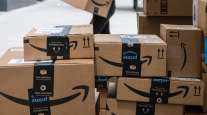Senior Reporter
Strong Holiday Orders, Close Ties to Amazon Boost UPS Q4 Earnings

[Stay on top of transportation news: Get TTNews in your inbox.]
UPS Inc., fueled by demand from e-commerce giant Amazon.com, on Jan. 30 reported a gain in fourth-quarter profit on an adjusted basis and in revenue while noting a one-time charge that dragged net results.
The results followed its Jan. 29 announcement of a series of offerings aimed at improving service to small and midsize businesses, including an extension of weekend operations, as well as plans for a “superhub” in Pennsylvania.
On an adjusted basis, UPS net income rose to $1.84 billion, or $2.11 a share, compared with $1.69 billion, or $1.94 a share, the year before.
We are continuing our transformative roll-out of innovative new services and solutions, squarely focused on the needs of our customers, especially small and medium-sized businesses. Click here to learn how we're helping SMBs grow and compete. — UPS (@UPS) January 29, 2020
Revenue rose 3.6% to $20.57 billion compared with $19.85 billion a year ago.
Factoring in a $1.8 billion pension charge and $130 million in other expenses, the Atlanta-based company posted a net loss in the quarter of $106 million, or 12 cents, compared with a profit in the same year-ago period of $453 million, or 52 cents.
The $130 million was attributed to a $39 million after-tax transformation charge and after-tax legal contingency and expense charges of $91 million tied to the settlement of a court case in New York.

Abney
“During the fourth quarter, we continued to successfully execute our strategies and deliver on our commitments,” CEO David Abney said during a Jan. 30 conference call to discuss the results. “We saw revenue growth, improved network efficiency to drive operating leverage and continued transformation to stay ahead of market changes.”
By segments, domestic business saw quarterly revenue jump more than 6.5% to $13.41 billion compared with $12.58 billion a year ago. Operating profit in the division jumped 7.5% to $1.07 billion from $999 million a year ago.
UPS said this division “experienced growth from a number of large and small- to medium-sized customers,” led by what it described as its largest customer, Amazon.com — which now represents 11.6% of its overall revenue.
UPS’ international segment had revenue that essentially was flat at $3.76 billion, while operating profit in the division rose about 2% to $799 million from $781 million.
Its supply chain and freight segment saw revenue of $3.40 billion, relatively stable with $3.44 billion. But operating profit surged 16% to $260 million from $244 million in the comparable quarter of 2018.
“We delivered more than 1.6 billion packages in the fourth quarter, including a record level of residential packages. This exceeded our expectations and resulted in a nearly 8% increase in volume over last year,” Abney said.
In part one of a two-part exploration of autonomous technology today, our latest RoadSigns podcast revisits conversations with CEOs Alex Rodrigues of Embark and Cetin Mericli of Locomation. Hear them explain what testing automated trucks and developing platooning technology has taught them about the road ahead — and get new perspective with host commentary. Listen to a snippet from Rodrigues above, and to hear the full episode, go to RoadSigns.TTNews.com.
Average daily volume levels exceeded 26.6 million packages, an increase of 7.5%, driven by a high demand for air services in the United States, the company said.
UPS said its quarterly results showed that the investments it’s making in its network are paying off, as consumers and businesses embrace online shopping and demand faster shipping. “Our transformation strategies and investments anticipated the growing significance of global e-commerce and positioned UPS well to capture opportunities from all customers,” Abney said.
For the full year, UPS said revenue rose 3.1% to $74.09 billion compared with $71.86 billion in 2018, while operating profit increased 10.4% to $8.15 billion compared with $7.38 billion a year ago.
Capital expenditures topped $6 billion, and the company repurchased more than 9 million shares for approximately $1 billion.
UPS said it is focusing much of its growth on companies that also are embracing e-commerce, including large companies such as Target, Best Buy and thousands of medium and smaller businesses.
“We’re embracing the e-commerce structure for faster delivery, which brought a surge in next-day air volume of more than 22% in 2019, an increase we were well-equipped to handle with greater efficiency,” Abney said.
Separately, UPS disclosed plans to expand Saturday and Sunday operations, preparing for what it said would be an anticipated doubling of weekend delivery volumes in 2020. The expansion includes new capacity, lane enhancements and more sorting operations to allow what it calls its “extended hours” service to reach 98% of the U.S. population, up from the 85% it reached when the service was announced in mid-2019.
The service enables shippers to process online orders later in the evening for local next-day ground delivery, UPS said.
Its plans to build an 800,000-square-foot “superhub” in Harrisburg, Pa., are expected to expand delivery service to large parts of the Northeast.
Superhubs are intended to be high-speed facilities using data and digital scanning to cut down on delivery times. The site was chosen in part because of its close location to interstates 81 and 76 and several state highways.
UPS ranks No. 1 on the Transport Topics Top 100 list of the largest for-hire carriers in North America.
Want more news? Listen to today's daily briefing:





